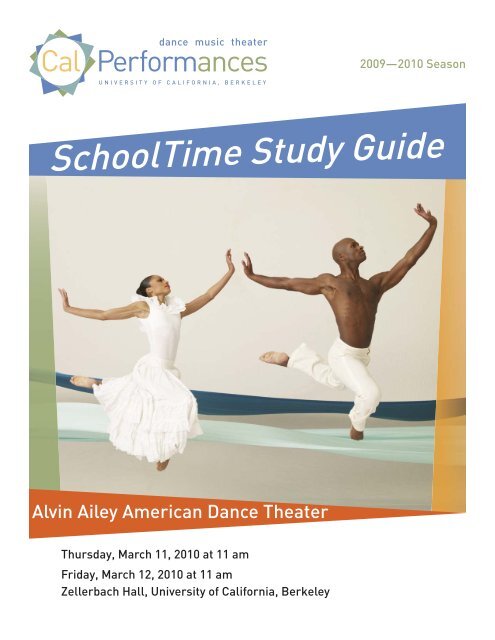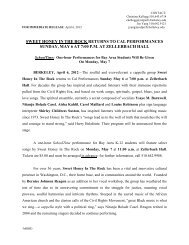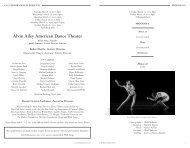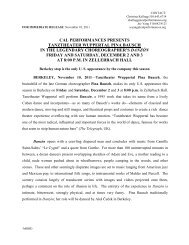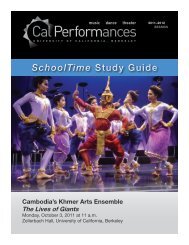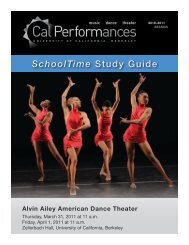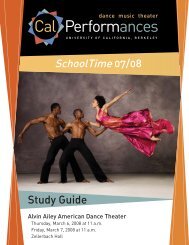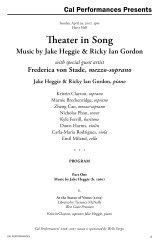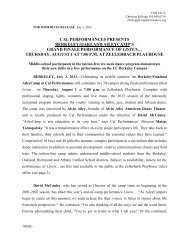Alvin Ailey American Dance Theater Study Guide 0910.indd - Cal ...
Alvin Ailey American Dance Theater Study Guide 0910.indd - Cal ...
Alvin Ailey American Dance Theater Study Guide 0910.indd - Cal ...
You also want an ePaper? Increase the reach of your titles
YUMPU automatically turns print PDFs into web optimized ePapers that Google loves.
Welcome to SchoolTime!Your class will attend a performance of <strong>Alvin</strong> <strong>Ailey</strong> <strong>American</strong> <strong>Dance</strong> <strong>Theater</strong> onThursday, March 11 or Friday, March 12 at 11am (check your confirmation form).An electrifying international presence for over 50 years, the <strong>Ailey</strong> company is committedto promoting dance as a medium for honoring the past, celebrating the present, andfearlessly reaching into the future. Its spectacular repertoire ranges from cutting-edgemodern choreography to spirituals, hip-hop, jazz, Afro-Caribbean rhythms, and rhythmand blues.Using This <strong>Study</strong> <strong>Guide</strong>You can use these materials to engage your students and enrich their field trip toZellerbach Hall. Before coming to the performance, we encourage you to:• Copy the student Resource Sheet on page 2 & 3 and give it to your studentsseveral days before the show.• Discuss the information on pages 4-9 About the Performance and About theArtists with your students.• Read to your students from About the Art Form on page 10 and About theMusic on page 12.• Engage your students in two or more of the activities on pages 15-17.• Reflect with your students by asking them guiding questions, which you can findon pages 2, 4, 10 & 12.• Immerse students further into the art form by using the glossary and resourcesections on pages 18-19.At the performance:Your students can actively participate during the performance by:• OBSERVING how the dancers express emotions and ideas through their movements• LISTENING to how the music and lyrics add to the meaning and emotional quality ofthe dance• THINKING ABOUT how music, costumes and lighting contribute to the overalleffect of the performance• MARVELING at the physical and mental discipline of the dancers• REFLECTING on the sounds, sights, and performance skills you experience at thetheaterWe look forward to seeing you at SchoolTime!SchoolTime <strong>Alvin</strong> <strong>Ailey</strong> <strong>American</strong> <strong>Dance</strong> <strong>Theater</strong> | III
Table of Contents1. <strong>Theater</strong> Etiquette 12. Student Resource Sheet 23. About the Performance & Artists 44. About the Art Form 105. About the Music 126. Learning Activities 157. Glossary 198. <strong>Cal</strong>ifornia State Standards 20About SchoolTime 21IV | SchoolTime <strong>Alvin</strong> <strong>Ailey</strong> <strong>American</strong> <strong>Dance</strong> <strong>Theater</strong>
1 <strong>Theater</strong> EtiquetteBe prepared and arrive early. Ideally you should arrive at the theater 30 to 45minutes before the performance. Allow for travel time and parking, and plan to be in yourseats at least 15 minutes before the performance begins.Be aware and remain quiet. The theater is a “live” space—you can hear theperformers easily, but they can also hear you, and you can hear other audience members,too! Even the smallest sounds, like rustling papers and whispering, can be heard throughoutthe theater, so it’s best to stay quiet so that everyone can enjoy the performance withoutdistractions. The international sign for “Quiet Please” is to silently raise your index finger toyour lips.Show appreciation by applauding. Applause is the best way to show yourenthusiasm and appreciation. Performers return their appreciation for your attention bybowing to the audience at the end of the show. It is always appropriate to applaud at the endof a performance, and it is customary to continue clapping until the curtain comes down orthe house lights come up.Participate by responding to the action onstage. Sometimes during aperformance, you may respond by laughing, crying or sighing. By all means, feel free to doso! Appreciation can be shown in many different ways, depending upon the art form. Forinstance, an audience attending a string quartet performance will sit very quietly, while theaudience at a gospel concert may be inspired to participate by clapping and shouting.Concentrate to help the performers. These artists use concentration to focustheir energy while on stage. If the audience is focused while watching the performance, theyfeel supported and are able to do their best work. They can feel that you are with them!Please note: Backpacks and lunches are not permitted in the theater. Bags will beprovided for lobby storage in the event that you bring these with you. There is absolutelyno food or drink permitted in the seating areas. Recording devices of any kind, includingcameras, cannot be used during performances. Please remember to turn off your cellphone.SchoolTime <strong>Alvin</strong> <strong>Ailey</strong> <strong>American</strong> <strong>Dance</strong> <strong>Theater</strong> | 1
2 Student Resource SheetAdapted from The KennedyCenter’s Cuesheet.Questions to Think About During the Performance• What does the <strong>Ailey</strong> company offer besides performances?• What influenced <strong>Ailey</strong>’s choreography?• What was the role of spirituals?What You’ll See /SchoolTime ProgramUptown (excerpt)Choreographer: Matthew RushingUptown is a vibrant tour through the HarlemRenaissance era in all its boisterous, swinging glory.In this new work by 18-year Company veteranMatthew Rushing, legends like Langston Hughes,Zora Neale Hurston, Josephine Baker and theircontemporaries come alive to the music of FatsWaller, Nat “King” Cole and more.RevelationsChoreographer: <strong>Alvin</strong> <strong>Ailey</strong>Revelations, made in 1960, is based on <strong>Alvin</strong> <strong>Ailey</strong>’schildhood memories of worshipping at his Baptistchurch in Texas. The music is a compilation ofAfrican <strong>American</strong> spirituals.About <strong>Alvin</strong> <strong>Ailey</strong> <strong>American</strong> <strong>Dance</strong><strong>Theater</strong><strong>Alvin</strong> <strong>Ailey</strong> created his dance companyin 1958. His intention was to make new andexpressive modern dance works based on African<strong>American</strong> culture and heritage. To make thecompany’s repertory (selection of works) varied,he included pieces by new and establishedchoreographers. Over its 50-year history, thecompany has performed for almost 20 millionpeople worldwide, and earned the reputationof one of the most popular <strong>American</strong> dancecompanies.The <strong>Alvin</strong> <strong>Ailey</strong> <strong>American</strong> <strong>Dance</strong> Center wasfounded in 1969, and today over 3,500 studentsfrom every part of the world receive training there.<strong>Ailey</strong>Camp was started in 1989. This unique2 |
across large distances.• Katherine Dunham incorporated Caribbean,African and <strong>American</strong> cultural dance styles tocreate unique movements.<strong>Alvin</strong> <strong>Ailey</strong>national program invites students aged 11-14 toattend a free summer day camp featuring dance,personal development and creative expressionclasses. <strong>Cal</strong> Performances hosts the Berkeley/Oakland <strong>Ailey</strong>Camp for six weeks every summer.After <strong>Ailey</strong>’s death in 1989, Judith Jamison,one of <strong>Ailey</strong>’s leading dancers, became thecompany’s director. Today, Jamison continues<strong>Ailey</strong>’s commitment to bringing dance to all people.About Modern <strong>Dance</strong> and <strong>Ailey</strong>’sChoreographyModern dance developed in <strong>American</strong>early 100 years ago as a reaction against therules and structure of ballet. In ballet, dancersappear weightless and perform elegant steps thatwere created hundreds of years ago. Moderndancers embrace gravity and create choreographyfrom everyday movements like walking, skipping,running, and falling.<strong>Ailey</strong> carefully observed ordinary peopleas they moved, then chose movements that hadthe most meaning for him and put them togetherin a dance. His unique choreographic style wasinfluenced by three modern choreographers—Lester Horton, Katherine Dunham and MarthaGraham.• Lester Horton’s dancers used as much spaceas possible while turning, bending, and jumping• Martha Graham’s dance technique wasbuilt on contraction (becoming smaller and morepressed together) and release—movements thatimitate the act of breathing. In a contraction, thedancer exhales and curves the spine; in a release,the dancer inhales and lifts the chest.About SpiritualsThe songs used in Revelations are calledspirituals. These are folk songs describing personalreligious experiences. When Africans werebrought to America as slaves, they lost theirtraditional music as well as their freedom. Theyadded African chants, rhythms and harmoniesto the Christian songs they learned and createdspirituals. Today, people sing spirituals to raise theirspirits, strengthen their faith, and create a sense ofcommunity. There are two kinds of spirituals:• Sorrow songs are sung slowly and sadly andtell of the heavy burden of slavery and the beliefthat better days are coming.• Jubilees are faster, upbeat songs based onBible stories celebrating victory and joy.Spirituals came to serve many purposes forthe slaves:• Work—Singing spirituals made work lessboring and set a rhythm for actions like picking ordigging. Slave owners liked the singing because itmade the slaves more productive.• Worship—At night, after the owners wereasleep, the slaves would go out into the woods(their invisible church) and worship. Spirituals werea big part of their religious ceremony.• Entertainment—At the end of a long day,slaves would often sing spirituals for relaxation.• Code Songs—Communication throughspirituals, often helped slaves escape. For example,a hidden message in the song “Deep River” ledto a meeting at the river. “Wade in the Water”warned an escaped slave to go into the river sobloodhounds couldn’t follow his scent.SchoolTime <strong>Alvin</strong> <strong>Ailey</strong> <strong>American</strong> <strong>Dance</strong> <strong>Theater</strong> | 3
3 About the Performance & ArtistsGuiding Questions:<strong>Alvin</strong> <strong>Ailey</strong> <strong>American</strong> <strong>Dance</strong> <strong>Theater</strong>♦♦♦What are some of dancer/choreographer <strong>Alvin</strong> <strong>Ailey</strong>’s achievements?What factors inspired <strong>Alvin</strong> <strong>Ailey</strong> to create Revelations?Name some of the <strong>Ailey</strong> company’ s programs for young people.SchoolTime ProgramRevelationsChoreography by <strong>Alvin</strong> <strong>Ailey</strong>, 1960Music: African <strong>American</strong> SpiritualsDecor and Costumes by Ves HarperCostume redesign by Barbara ForbesLighting by Nicola CernovitchUptownChoreography by Matthew Rushing, 2009Music: Nat “King” Cole, Fats Waller, andothersCostumes by Matthew Rushing withJon Taylor & Dante BaylorLighting by Al Crawford4 |
About Revelations (excerpts from the autobiography of <strong>Alvin</strong> <strong>Ailey</strong>)The Inspiration for RevelationsRevelations began with the music. As early as Ican remember I was en thralled by the music playedand sung in the small black churches in every smallTexas town my mother and I lived in. No matterwhere we were during those nomadic years, Sundaywas always a church-going day.With profound feeling, with faith, hope, joy andsometimes sadness, the choirs, congregations,deacons, preachers, and ushers would sing blackspirituals and gospel songs. They sang and playedthe music with such fervor that even as a small childI could not only hear it but almost see it. I tried toput all of that feeling into Revelations.Creating the <strong>Dance</strong>The opening part of Revelations was abouttrying to get up out of the ground. The costumesand set would be colored brown and earth color,for coming out of the earth, for going into the earth.The second part was something that was very closeto me—the baptismal, the purification rite. Itscolors would be white and pale blue. Then therewould be the section surrounding the gospel church,the holy rollers, and all that church happiness. Itscolors would be earth tones, yellow, and black.The first version of Revelations was quitelong, an hour and five minutes, and it had threesections. The first was called “Pilgrim of Sorrow.”I took all the songs dealing with black people’ssorrow and put them in this section. The middlesection was to be wading in the water. Songs suchas “Honor, Honor” had all the extraordinary words.I was moved by what spirituals say as words, asmetaphors. So I found these short songs for themiddle section.There were quite a few songs for the lastsection, “Move, Members, Move.” The whole balletwas a gigantic suite of spirituals. I poured in justabout everything, every beautiful spiritual I had everheard.SchoolTime <strong>Alvin</strong> <strong>Ailey</strong> <strong>American</strong> <strong>Dance</strong> <strong>Theater</strong> | 5
Major figures of the HarlemRenaissanceZora Neale HurstonBorn in 1891, Zora NealeHurston grew up inEatonville, Florida, thefirst all-Black town to beincorporated in the UnitedStates. She graduatedfrom Barnard College,where she studied withnoted anthropologist Franz Boas. A writer,anthropologist and folklorist, Hurston collectedAfrican-<strong>American</strong> folktales in the rural Southand assembled them in the collections Mulesand Men (1935) and Tell My Horse (1938).Hurston also wrote the influential Their EyesWere Watching God (1937).About Uptown, choreographed byMatthew RushingDubbed “a glittering love letter to theHarlem Renaissance” by the New York Times,Matthew Rushing’s Uptown captures the mood,energy and major personalities of the erain which African <strong>American</strong> culture and artsblossomed.The Harlem RenaissanceThe Harlem Renaissance was the namegiven to the cultural, social, and artisticexplosion that took place in the New Yorkneighborhood of Harlem between the end ofWorld War I and the middle of the 1930s. Duringthis period, Harlem was a cultural center,drawing black writers, artists, musicians,Langston HughesLangston Hughes wasborn in Joplin, Missouriin 1902 and made a namefor himself with The WearyBlues (1926), a collection ofpoems influenced by jazzrhythms. His later poetrycollections, notably Montageof a Dream Deferred (1951), cemented hisreputation as the “Negro Poet Laureate.” Hispoetry, as well as novels, children’s books, plays,musicals, radio scripts, and autobiographies,reflected his belief that race consciousness andpride could be transmitted through literatureand art. Using elements from black culture,Hughes engaged his audience while blurring theline between perceived high and low culture. Healso founded black theaters in Chicago, Harlem,and Los Angeles.Josephine BakerA talented dancer andsinger, Josephine Bakerwas born in St. Louis,Missouri in 1906. Sheappeared in Broadwaychorus lines, then openedin La Revue Nègre in Parisin 1925 and became an immediate celebrity,renowned for her jazz singing, dancing, andprovocative costumes. By 1927 she was oneof Europe’s most famous and highly paidentertainers. She continued to perform forover 50 years. Naturalized as a French citizenin 1937, she worked for the Resistance inWorld War II and in 1961 was awarded theFrench Legion of Honor.6 |
photographers, poets, and scholars. Many camefleeing the racial oppression of the South and therace riots happening in many <strong>American</strong> cities,hoping to find a place where they could freelyexpress their talents and thrive in a supportive,creative community. And while many jobs in NewYork discriminated against African <strong>American</strong>s,the arts provided a venue for success, as wellas a forum for commenting on racial injustice.The artists believed that by creating stories,plays, poems and music based on their personalexperiences they could define the African <strong>American</strong>experience of their time, unite black <strong>American</strong>s andchange people’s attitudes about racism.The Influence of the Harlem RenaissanceJazz and the blues developed, thrived andgained nationwide (and later worldwide) popularitythanks to talented composers like Duke Ellingtonand musicians like Louis Armstrong. Fashionableentertainment venues like the Apollo <strong>Theater</strong>, theSavoy Ballroom, the Cotton Club, and a variety ofspeakeasies attracted white patrons to Harlem. Inthese places, blacks and whites could mingle andinterracial couples could dance openly together.Unfortunately, the Harlem Renaissance hadlittle impact on breaking down the rigid barriersof Jim Crow laws that separated races. Whileit contributed to a certain relaxation of racialattitudes among young whites, perhaps theRenaissance’s greatest impact was to reinforce asense of pride and to energize African <strong>American</strong>s tostrive for civil rights.Fats WallerBorn Thomas WrightWaller in New York in1904, Fats Waller was aprotégé of jazz pianistand composer James P.Johnson, who gave himlessons and furtheredhis career. Later, atJulliard School hestudied with composers Carl Bohm andLeopold Godowsky. During the 1920s and30s, Waller appeared in night-clubs andtheaters, composed songs for Broadwaymusicals and made many recordings.Waller’s style influenced a number ofjazz pianists. His compositions includeAin’t Misbehavin’, Black and Blue,Honeysuckle Rose, and London Suite.W.E.B. DuBoisBorn William EdwardBurghardt DuBois inMassachusetts in 1868,scholar and politicalactivist W.E.B. DuBoiswas the first African<strong>American</strong> to receive adoctorate from HarvardUniversity in 1895. Hebecame a universityprofessor, a prolific writer and apioneering social scientist on the topic ofblack culture. DuBois championed globalAfrican unity and (especially in lateryears) separatism, and sharply disagreedwith black leaders such as BookerT. Washington who urged integrationinto white society. In 1909, he helpedfound the National Association for theAdvancement of Colored People (NAACP),an organization promoting progress andsocial equality for African <strong>American</strong>s. Heleft the US to become a citizen of Ghanain 1961, shortly before his 1963 death.SchoolTime <strong>Alvin</strong> <strong>Ailey</strong> <strong>American</strong> <strong>Dance</strong> <strong>Theater</strong> | 7
<strong>Alvin</strong> <strong>Ailey</strong> <strong>American</strong> <strong>Dance</strong> <strong>Theater</strong>For over 50 years, <strong>Alvin</strong> <strong>Ailey</strong> <strong>American</strong><strong>Dance</strong> <strong>Theater</strong> has brought African<strong>American</strong> cultural expression and the<strong>American</strong> modern dance tradition to theworld’s stages.Mr. <strong>Ailey</strong> founded his company in1958. Over the next 10 years, he createdapproximately 20 ballets, among themRevelations (1960). He ensured thatthe company’s repertory also includedworks by dance pioneers and emergingchoreographers. Over the past 50 years,the company has produced more than 180works by 77 choreographers. Performingfor an estimated 19 million people in 48states, 68 countries and on six continents,<strong>Alvin</strong> <strong>Ailey</strong> <strong>American</strong> <strong>Dance</strong> <strong>Theater</strong> hasearned a reputation as one of the mostpopular international ambassadors of<strong>American</strong> culture.The <strong>Alvin</strong> <strong>Ailey</strong> <strong>American</strong> <strong>Dance</strong>Center was founded in 1969 with an initialenrollment of 125 students. Today, over3,500 dance students from every part ofthe world receive training there. Thisdiverse group of students contributes toa multicultural richness that is uniqueamong dance schools.The company has a long-standinginvolvement in arts education,including a unique national programcalled <strong>Ailey</strong>Camp. <strong>Ailey</strong>Camp bringsunderserved youngsters to a fullscholarshipsummer day camp thatcombines dance classes with personaldevelopment, creative writing classesand field trips. Berkeley/Oakland<strong>Ailey</strong>Camp is now in its ninth year at <strong>Cal</strong>Performances.<strong>Alvin</strong> <strong>Ailey</strong> (1931-1989)Born in Rogers, Texas, on January5, 1931, <strong>Alvin</strong> <strong>Ailey</strong> spent his formativeyears going to Sunday School andparticipating in the Baptist Young PeoplesUnion – experiences that later inspiredRevelations.<strong>Ailey</strong> began his formal dance trainingin Los Angeles motivated by performancesof the Katherine Dunham <strong>Dance</strong> Companyand classes with Lester Horton. Horton,the founder of the first racially integrateddance company in the United States, wasa catalyst for <strong>Ailey</strong>’s career. After Horton’sdeath in 1953, <strong>Ailey</strong> became the directorof the Horton <strong>Dance</strong> <strong>Theater</strong> and began tochoreograph his own works. Soon after hefounded the <strong>Alvin</strong> <strong>Ailey</strong> <strong>American</strong> <strong>Dance</strong><strong>Theater</strong>.<strong>Alvin</strong> <strong>Ailey</strong> died on December 1, 1989,and with his death <strong>American</strong> dance lostone of its most luminous stars. AnnaKisselgoff of The New York Times wrote8 |
“You didn’t need to have known <strong>Alvin</strong>personally to have been touched by hishumanity, enthusiasm and exuberanceand his courageous stand for multiracialbrotherhood.”Judith Jamison, Artistic DirectorA native of Philadelphia , JudithJamison became a member of <strong>Alvin</strong> <strong>Ailey</strong><strong>American</strong> <strong>Dance</strong> <strong>Theater</strong> in 1965 anddanced with the company for 15 years togreat acclaim. She was appointed ArtisticDirector of <strong>Alvin</strong> <strong>Ailey</strong> <strong>American</strong> <strong>Dance</strong><strong>Theater</strong> in December 1989 at the requestof her mentor, <strong>Alvin</strong> <strong>Ailey</strong>. When namedArtistic Director of the Company, she said“I view this appointment as the course totake to continue my vision and keep Mr.<strong>Ailey</strong>’s vision alive.”This year, Ms. Jamison celebratesher 20th anniversary as Artistic Director,residing over a renewed organization,both artistically and fiscally energized.Following <strong>Alvin</strong> <strong>Ailey</strong>’s ideals, Ms.Jamison is dedicated to asserting theprominence of the arts in our culture,spearheading initiatives to bring danceinto the community and programs thatintroduce children to the arts. Sheremains committed to promoting the <strong>Ailey</strong>legacy—dance as a mediumfor honoring thepast, celebratingthe presentand fearlesslyreaching into thefuture.Matthew Rushing, Choreographerand <strong>Dance</strong>rBorn inLos Angeles,<strong>Cal</strong>ifornia,Matthew Rushingbegan his dancetraining at theLos AngelesCounty HighSchool for theArts. While inhigh school,he received a Spotlight Award and wasnamed a Presidential Scholar in the Arts.At the age of 18, he began training at The<strong>Ailey</strong> School in New York City and laterbecame a member of <strong>Ailey</strong> II, where hedanced for a year. Mr. Rushing joined theCompany as a dancer in 1992. Mr. Rushinghas performed as a guest artist for galasin France, Russia, Canada and Hungaryand performed for former presidentBill Clinton’s inaugural presidentialcelebration. In 2003, he performed atThe White House State Dinner in honor ofthe President of Kenya, Mwai Kibaki. Mr.Rushing choreographed the new pieceUptown for the current season of <strong>Alvin</strong><strong>Ailey</strong> <strong>American</strong> <strong>Dance</strong> <strong>Theater</strong>.<strong>Alvin</strong> <strong>Ailey</strong> and Judith JamisonSchoolTime <strong>Alvin</strong> <strong>Ailey</strong> <strong>American</strong> <strong>Dance</strong> <strong>Theater</strong> | 9
5 About the Art FormGuiding Questions:♦♦♦What types of dance influenced <strong>Alvin</strong> <strong>Ailey</strong>’s choreography?What qualities are special in the Horton technique?What are the characteristic elements of modern dance?Modern <strong>Dance</strong>Created in America about 100 yearsago, modern dance is a much younger artform than ballet or folk dance.Ballet began in France in the1600s,and for almost 500 years ballet dancershave performed classical ballet’s traditionalsteps and movements. Ballet choreographyemphasizes symmetry and repeatingpatterns, and dancers hold their bodiesstraight and try to give the illusion ofweightlessness.Modern dance developed in the 20thcentury, primarily in the United States andGermany, as a rebellious response to thetraditional rigidity of classical ballet. Knownfor its invention, independent attitude and“modern” sensibility, modern dance’svocabulary pushed the boundaries set bytraditional schools of dance, expanding thestandardized movements of ballet to includeeveryday actions like walking, running andfalling.Modern dance pioneers like IsadoraDuncan, Ruth St. Denis and Rudolf vonLaben each sought to inspire audiences to anew awareness of how the body could moveand express emotion. Every modern dancecompany has its own style and uniquemovement vocabulary depending on theartistic director’s own creative talents.<strong>Alvin</strong> <strong>Ailey</strong> <strong>American</strong> <strong>Dance</strong><strong>Theater</strong> performs dances by differentchoreographers, including many by itsfounder <strong>Alvin</strong> <strong>Ailey</strong>. Mr. <strong>Ailey</strong> developedhis unique style of choreography throughhis knowledge and use of several moderndance techniques including those of LesterHorton, Katherine Dunham, and MarthaGraham, as well as utilizing African dance,ballet, jazz and the observed “pedestrian”movement of everyday people. Hecombined all the movements he found mostengaging.10 |
Whatever the particulars, all dancescontain the principles of choreography:putting movements together artfullyin interesting, thought-provoking orinspiring ways. Even when there is no“story” with characters or a beginning,middle and end, dance expresses manyemotions, ideas and moods.<strong>Dance</strong> TechniquesHortonCreated by Lester Horton, this is atechnique that explores how many differentways the body can move. Horton namedthese movements “studies.” Some studiesare for balance, some for strengtheningand some for working on the swingingaction of the body. A Horton dancer usesas much space as possible: turning,bending and jumping sideways, backwardsand even upside-down. The shapescreated are clear and linear. The Hortontechnique gives a feeling of strength andenergy.DunhamCreated by Katherine Dunham, thistechnique blends Caribbean, West Africanand African <strong>American</strong> folk patterns ofmovement and rhythms. The originaldance patterns have been preserved, butthe dances have been slightly modifiedin keeping with modern dance form. Thetechnique also employs the styles ofballet, modern dance, jazz and basic folkpatterns.GrahamMartha Graham created a techniquebased on the principle of contraction andrelease, movement that is similar to theact of breathing, which creates a currentof energy through the body. The backappears rounded in a contraction and thechest is lifted in a release. Movement itselfis dramatic and expressive.Martha GrahamKatherine DunhamSchoolTime <strong>Alvin</strong> <strong>Ailey</strong> <strong>American</strong> <strong>Dance</strong> <strong>Theater</strong> | 11
6 About the MusicGuiding Questions:♦♦♦What are spirituals?Why were spirituals important to slaves?What are common themes in spirituals?African <strong>American</strong> SpiritualsSlave SongsWhen Africans were brought toAmerica as slaves in the 1700s and 1800s,they entered a frightening and dangerousworld. However, music, especiallysinging, was the one thing gave slavescomfort in spite of the many hardshipsthey endured.When slaves sang together, theycreated a feeling of community. Althoughthey were forced to convert to Christianity,the slaves created their own religiousworship called a camp meeting. Peoplewent into the woods and fields, campedout in tents and attend worship services.There, they took part in the dances andsong rituals of their homeland, andsang Christian songs of faith, hope andsuffering. Camp meetings were a way forpeople who lived far from a church to gettogether and worship.the song that repeats after each verse sopeople could sing them without needinga book. <strong>Cal</strong>l and response also madewritten music unnecessary. In this form,a leader begins a song (the call), andeveryone else answers or repeats the call(the response).As these songs were passed onthrough oral tradition they didn’t alwayshave a set number of verses or evenspecific words. Leaders often made upverses so that the spiritual reflected thelives and emotions of the community. Asa result, every performance of a spiritualwas unique.This was the beginning of thesong form called spirituals, born fromthe mingling of Protestant hymns withAfrican musical traditions. “Michael, Rowthe Boat Ashore,” “Swing Low, SweetChariot” and “Go Down, Moses” are someexamples.12 |Since most of the people at campmeetings could not read or write, thesongs had to be easy to remember andsing. Therefore, spirituals often userepetition and have a chorus—a part of
The Function of SpiritualsSpirituals spread from camp meetings toplantations, becoming part of the every daylives of slaves until the Civil War. Thesewere functional songs, meaning that theyhad a specific purpose in society. Forexample:1. WORK. Singing made work less boringand set a rhythm for repetitive work likepicking or digging. Slave owners likedthis because it made the slaves moreproductive.2. WORSHIP. Even though some ownersdidn’t allow their slaves to worship, slavesfound ways to make their own “invisiblechurch.” At night, after the owners wereasleep, the slaves would go into the woods(their invisible church) and worship, whereno one could see or hear them. Spiritualswere an important part of this worship.3. ENTERTAINMENT. At the end of a longday, or during time off on a Sunday, slaveswould often sing spirituals for relaxation.4. CODE SONGS. An important function ofspirituals was their use in helping slavesescape. Code songs are songs that havehidden messages. The spiritual, “DeepRiver,” for example, was sung to announcea meeting at the river:Deep riverMy home is over Jordan, yesDeep river, Lord,I want to cross over into camp groundWhen the master had discovered theabsence of a runaway slave, the otherslaves on the plantation might sing “Wadein the Water.” Slaves on neighboringplantations would hear the song and takeit up, and the runaway, wherever he was,would know that he should take to the riverso the bloodhounds would not be able tofollow his scent.Performance of SpiritualsThere are two kinds of spirituals:• Sorrow songs are sung slowly andmournfully, and told of the heavy burdenof slavery and the belief that a better daywas coming.• Jubilees are up-tempo songscelebrating victory and joy throughreference to biblical figures like Samsonor David who overcame tremendoushardships.The Music of RevelationsRevelations is a dance in threesections, each choreographedto a selection of spirituals. Thefollowing pages include the lyricsto a sampling of the music fromRevelations.1. Pilgrim of Sorrow“I Been ‘Buked”“Didn’t My Lord Deliver Daniel”“Fix Me, Jesus”2. Take Me to the Water“Wade in the Water”“A Man Went Down to the River”“I Want to Be Ready”3. Move Members Move“Sinner Man”“The Day Is Past and Gone”“You May Run On”“Rocka-My-Soul”SchoolTime <strong>Alvin</strong> <strong>Ailey</strong> <strong>American</strong> <strong>Dance</strong> <strong>Theater</strong> | 13
Section 1: Pilgrim ofSorrowI’ve Been ‘BukedI’ve been ‘buked an’ I’ve been scorned, Yes,I’ve been ‘buked an’ I’ve been scorned,ChildrenI’ve been ‘buked an’ I’ve been scorned,I’ve been talked about sho’s you’ born.Dere is trouble all over dis worl’, Yes,Dere is trouble all over dis worl’, Children.Dere is trouble all over dis worl’Dere is trouble all over dis worl’Ain’ gwine lay my ‘ligion down, No,Ain’ gwine lay my ‘ligion down, Children.Ain’ gwine lay my ‘ligion down,Ain’ gwine lay my ‘ligion down.I’ve been ‘buked I’ve been scorned, YesI’ve been ‘buked I’ve been scorned, Children.I’ve been ‘buked I’ve been scorned.I’ve been talked about sho’s you’ born.Fix Me JesusOh, fix me, Oh, fix me, Oh, fix me.Hm——— Hm———-Fix me, Jesus, fix me.Hm——— Oh, fix me, Oh, fix me,Oh, fix me. Fix me, Jesus, fix me.Fix me for my long, white robe.Hm——— Fix me, Jesus, fix me.Fix me for my starry crown.Hm——— Fix me, Jesus, fix me.Oh, fix me, Oh, fix me, Oh fix me.Fix me, Jesus, fix me.Hm——— Fix me, Jesus, fix me.Fix me for my dyin’ bed.Hm——— Fix me Jesus, fix me.Hm——— Fix me Jesus, fix me.Fix me for my journey home.Hm——— Fix me Jesus, fix me.Oh, fix me, Oh, fix me, Oh, fix me, Lord.Oh, fix me, Oh,Fix me, Jesus, fix me. Hm———Fix me, oh, fix me. Fix me, Jesus, fix me.Section 2: Take Me to theWaterWade in the WaterWade in the water (4x).Wade in the water, children, wade in the water.God’s a gonna trouble the water.God’s a gonna trouble that band all dressedin white.God’s gonna trouble the water.It look like the band of the Israelite.God’s gonna trouble the waterWade in the water.Wade in the water children.Wade in the water.God’s a gonna trouble the water.See that band all dressed in red.God’s gonna trouble the water.Look like the band that Moses led.God’s gonna trouble the water.Wade in the water.Wade in the water children.Wade in the water.God’s a gonna trouble the water.Didn’t my Lord deliver Danuwell (Daniel)Danuwell Danuwell?Didn’t my Lord deliver Danuwell and a whynot a every man.Man went down to the river (2x)Lord, man went down to the river.He went down there to pray.Wash his sins away.He wash all day. He wash all night.He wash ‘til his hand were sore. He washall day.He wash all night ‘til he couldn’t wash em nomore.Man went down to the river. He went downthere to pray.Wash his sins away.Wade in the water. Wade in the water,Children wade in the water.God’s a gonna trouble the water (x3)I Wanna Be ReadyI wanna be ready, I wanna be ready, I wannabe ready,Lord, ready to put on my long white robe.Lord, I wanna be ready, I wanna be ready, Iwanna be ready,Lord, ready to put on my long white robe.I would not be a sinner, I’ll tell you the reasonwhy,‘Cause if my Lord should call on me,Lord, I wouldn’t be ready to die.I wanna be ready, I wanna be ready, I wannabe ready.Lord, ready to put on my long white robe.Lord, I wanna be ready, I wanna be ready, Iwanna be ready.Lord, ready to put on my long white robe.I would not be a gambler, I’ll tell you thereason why.‘Cause if my Lord should call on me,Lord, I wouldn’t be ready to die.I wanna be ready, I wanna be ready, Lord, Iwanna be ready,Lord, ready to put on my long white robe,Be ready to put on my long white robe,Jus’ ready to put on my long white robe.Section 3: Move,Members, MoveThe Day Is Past and GoneThe day is past and gone.The evening shades appear.Oh may we all remember well that the nightof death draws nigh.You May Run OnYou may run on for a long time. Run on for along time.You may run on for a long time.Let me tell you a God a mighty gonna cut youdown.Go tell that long-tongued liar, go tell thatmidnight rider.Tell the gambler, rambler back-biter.Tell him God a might gonna cut him down.My head got wet with the midnight dew.The mornin’ star was a witness too,I never shall forget that day when Jesuswashed my sins away.One day, one day, I was walkin’ along heard avoice and saw no one.Voice I heard it sound so sweet made his loverun down to my feet.Go tell that long-tongued liar, go tell thatmidnight rider.Tell the gambler, rambler back-biter.Tell him God a might gonna cut him down.You read about Samson from his birth,Strongest man whoever lived on earth.He lived way back in ancient time.Died and went to heaven in due time.Delilah fooled Samson. Don’t you know theHoly Bible tells you so.She came to Samson on her knees said,Tell me where your strength lies if you please.Delilah she looked so fair,Samson said, my strength lies in my hair.She shaved his head just as clean as yourhand,Samson got weak as any other man.Go tell that long tongued liar, go tell thatmidnight rider.Tell the rambler, gambler back biter.Tell him God a mighty gonna cut him down.A for Adam man was named placed in thegarden by God’s command.God saw Adam in a lonely state.Put him to sleep and made him a mate.Now Adam bein’ the father of the human race,Broke God’s law and tried to hide his face.In the cool of the evenin’ my Lord came down,Looked at Adam and began to frown.Adam! Adam! Where are you now?You must earn your bread by the sweat of yourbrow.Go tell that long tongued liar. Go tell thatmidnight rider.Tell the rambler, gambler back biterTell him God a mighty gonna cut him down.Some people go to church for to signify,Tryin’ to make a date with the neighbor’s wife,But neighbor, let me tell you,Just as sure as you’re born you better leavethat woman,Better leave her alone, ‘cause one of thesedays,Better mark my words, you’ll think yourneighbor has gone to work,You walk right up and knock on the door,That’s all brother you’ll knock no more.Go tell, tell that long tongued liar. Go tell thatmidnight riderTell the gambler, rambler back biter.Tell him God a mighty gonna cut him down.14 |
7 Learning ActivitiesPre-show ActivitiesAn effective way to engage your students in the performance and connect to literacy,social studies, arts and other classroom curriculum is to guide them through thesestandards-based activities before they come to the theater.<strong>Dance</strong> (Grades 3- 12)Everyday Movement1) Ask students to brainstorm a list of every day activities, for example; stretching whenthey wake up, walking the dog, skipping rope or jumping and throwing a basketball.2) In groups of six, have students share their activity, show its movement, then have theother students repeat this movement.3) After students have shared their movements, set the movements by having studentsgo over them again, this time making sure each movement lasts for eight counts.4) Then, ask students to create an order in which to perform all six, eight-countmovements.5) Next, ask students to think of the quality they would like for each movement. Forexample, do they want to do the movement slowly and fluidly or quickly and jerkily?6) Finally, how much space should the movement take up—is the body stretched outwith the legs taking large steps, or crunched into a little ball and hardly moving?7) After repeating the movements in their chosen order several times, ask students toshare their pieces.Literacy & Visual Art (Grades 3-8)Poems inspired by spiritualsRemembering the spirituals he heard as a child, <strong>Alvin</strong> <strong>Ailey</strong> was inspired to createRevelations. Spirituals are still powerful today not only because of their historical and culturalsignificance, but because their messages are filled with strong human desires and emotions.1) Student Response:• Play a recording of a spiritual for the class.• Ask students to listen to the music once, just to hear it.• Play the piece again, and ask students to write words describing the emotions thesong makes them feel or think about.• Ask students to share with a partner some of the words• Repeat the song, and ask students to draw a picture inspired by the music.• After posting the drawings, have students do a “gallery walk” around the room.SchoolTime <strong>Alvin</strong> <strong>Ailey</strong> <strong>American</strong> <strong>Dance</strong> <strong>Theater</strong> | 15
• Hand out small post-it notes to students and ask them to do another “gallerywalk.” This time, ask students to suggest titles for drawings, which they can write onthe post-it note and place near the drawing.(Set ground rules about acceptable and non-acceptable titles).• After students read the suggested titles, play the song again and ask them to writedown words connected with the history and culture of spirituals that come to mindwhen they listen to the music.2) Creating a poem inspired by the spiritual• Ask students to choose up to five words from the ones they’ve written or received astitle suggestions.• Ask students to create a short poem or haiku using these words.• Share some of the poems.• Extension: In groups, have students choose a poem and create gestures, poses andeventually large movements to express words or phrases in the poem.Post-show ActivitiesReflecting on the performance allows students to use their critical thinking skills as theyanalyze and evaluate what they observe during the performance. Student reflection alsohelps teachers assess what students are taking in, and what they aren’t noticing.<strong>Dance</strong> (Grades K-12)Reflection on RevelationsImmediately after seeing the performance of Revelations, ask students to remembermovements and gestures. With the students arranged in a circle, ask each one to copy amovement they saw in the performance. Students can work in pairs, showing a movementfrom a duet. After seeing all the movements, ask students to share what they think someof these movements or gestures represent in terms of ideas or emotions. (Use the sectionMovements to Watch for in Revelations on page 15 to help with this discussion.)Class Discussion1) What do you think the dance Revelations is about? How did movement, costume, musicand lighting convey the meaning of the dance?2) <strong>Dance</strong> is the language of the body. Discuss this statement. Would you consider dancea universal language? Can you give examples of how you understand other people’sintentions and messages through their movements? How can you tell if someone is reallynervous, happy or angry? Have you seen anyone who seems frightening just from their bodylanguage? What kinds of movements are welcoming gestures?16 |
Movements to Watch for In RevelationsRevelations is a suite of dances that tells the story of a community of people throughvignettes composed of large and small groups, trios, duets and solos. Concepts such asoppression, dignity, hope and determination, and emotions like sorrow, anger, fear and joy,are embodied and expressed through human movement.Below is a list of specific dance gestures from Revelations. See if you can recognize some ofthe following moments as you watch the performance and identify the emotions or themes.As everyone has a unique frame of reference, a particular moment may say somethingdifferent to you than to other people. The dance is rich with imagery—the list here containsonly a few of them. Have your students make note of which scenes particularly stand out tothem in order to spark a class discussion following the performance.1. THE “BIRD” POSE. How many times did you see it performed as a group in “I Been’Buked?” In various sections of Revelations, a similar movement is done. Look for the “bird”pose repeated throughout the dance.2. PRAYING MOVEMENTS: Notice the number of different ways praying takes place inRevelations. Think about how it is portrayed and why and where it is done. Students canalso share through movement or drawing.3. FALLING TO THE FLOOR IN GRIEF AND DESPAIR happens in three different segments ofthe dance. When do they happen and what do you think they represent?4. RISING INTO THE AIR IN HOPE: In “Fix Me,” one woman is so overcome with despair shefaints twice, but in the end she ascends toward the sky as if on wings.5. LOOKING FOR A PLACE TO HIDE: In the section “Sinner Man,” some of the dancers tryto hide. Who do you think they represent? What feelings did you experience while watchingthe dance?6. A MAN AND A WOMAN CLEAR AWAY EVIL SPIRITS: Why do you think they are doingthis? What props do the dancers use to accomplish their task?7. THREE PEOPLE WALK INTO A RIVER: How do you know they are in water?8. A MAN CRAWLS ON THE FLOOR IN DETERMINATION: What do you notice about the wayhe moves? What else do his gestures convey?9. SEVERAL WOMEN CARRY ON STOOLS: Where are they? What are the doing? Whatemotions are they showing at this time?10. THE WOMEN PLAYFULLY CHASTISE THE MEN: What gestures do they use to do this?11. MEN CARRY THE STOOLS: Why might they do this?12. THE COMPANY IS SWEPT AWAY IN JOY: Describe how the dancers portray this emotion.SchoolTime <strong>Alvin</strong> <strong>Ailey</strong> <strong>American</strong> <strong>Dance</strong> <strong>Theater</strong> | 17
Resources<strong>Alvin</strong> <strong>Ailey</strong> <strong>American</strong> <strong>Dance</strong> <strong>Theater</strong>http://www.alvinailey.org/Books:<strong>Ailey</strong>, <strong>Alvin</strong> and A. Peter Bailey. Revelations: The Autobiography of <strong>Alvin</strong> <strong>Ailey</strong>.Secaucus, NJ: Birch Lane Press, 1995.Dunning, Jennifer. <strong>Alvin</strong> <strong>Ailey</strong>: A Life in <strong>Dance</strong>. New York, NY: DeCapo Press, 1998.Pinkney, Andrea Davis. <strong>Alvin</strong> <strong>Ailey</strong>. New York, NY: Hyperion Books for Children,1993.DVD / Video:Four by <strong>Ailey</strong> VHS. Director Thomas Grimm. <strong>Dance</strong> Horizons, 1986.Beyond the Steps: <strong>Alvin</strong> <strong>Ailey</strong> <strong>American</strong> <strong>Dance</strong> <strong>Theater</strong> DVD. Director PhilBertelsen. <strong>Dance</strong> Philm, 2006. Order at: http://www.aileyboutique.com/dvd/http://youtube.com/watch?v=gWJzSP7irwMhttp://youtube.com/watch?v=WefribGizyg&feature=relatedVideo selections from the <strong>Ailey</strong> repertory:http://www.alvinailey.org/page.php?p=arti&v=611CD / Tape:<strong>Alvin</strong> <strong>Ailey</strong> <strong>American</strong> <strong>Dance</strong> <strong>Theater</strong>. Revelations. V2 Records 63881-27036-2,1998.Order at: http://www.aileyboutique.com/dvd/Podcasts:NPR: <strong>Alvin</strong> <strong>Ailey</strong>’s <strong>Dance</strong> Troupe at 45http://www.npr.org/templates/story/story.php?storyId=1912037Websites:<strong>Alvin</strong> <strong>Ailey</strong> at <strong>Cal</strong> Performances:http://www.calperfs.berkeley.edu/presents/season/2009/dance/aaadt.php18 |
8 GlossaryBallet: A dance form started in the royalcourts of Europe. The body is held mostlyupright and the legs are turned out fromthe hip. Ballet uses five basic positions ofthe feet. Ballet terms are always spoken inFrench.Arabesque: A ballet position where a dancerbalances on one leg, raises and extends theother leg behind them, and stretches theirarms forward.Artistic director: A person who has artisticcontrol of a company’s work. They will oftenchoose a company’s season and direct severalworks.<strong>Cal</strong>l and Response: A style of singing inwhich the melody sung by one singer isresponded to or echoed.Choreographer: A person who composesdance works.Duet: Any performance by two people.Dynamics: Variation and gradation in theintensity of a movement or musical sound.Ensemble: The united performance of anentire group.Folk <strong>Dance</strong>: A style of dance that originatesamong the common people of a particularnation or region.Movement Vocabulary: <strong>Dance</strong> movementsthat commonly appear in a choreographer’sworks.Repertoire/Repertory: The list of works thata company is prepared to perform.Repertory Company: A dance companythat performs many types of works by manydifferent choreographers.Salsa: A lively, vigorous type of contemporaryLatin <strong>American</strong> popular music that blendspredominantly Cuban rhythms with elementsof jazz, rock, and soul music.Solo: Any performance by one person.Spirituals: Religious songs created byAfrican <strong>American</strong> slaves, the lyrics are oftenbased on stories from the Bible.Symmetry: An exact matching of form andarrangement of parts on opposite sides of acentral point or axis.Tribute: A gift, payment, declaration, or otheracknowledgment of gratitude, respect, oradmiration.Trio: A group of three.Vignette: A short scene or moment, as froma play.Work: A word that dancers use to refer toa dance; other words that are used in thismanner are “piece” and “ballet.”SchoolTime <strong>Alvin</strong> <strong>Ailey</strong> <strong>American</strong> <strong>Dance</strong> <strong>Theater</strong> | 19
9 <strong>Cal</strong>ifornia State StandardsMusic Grades K-121.0 Artistic PerceptionProcessing, analyzing, and responding to sensoryinformation through the language and skills uniqueto musicStudents listen to, analyze, and describe music andother aural information, using the terminology ofmusic.3.0 Historical and Cultural ContextUnderstanding the Historical Contributions andCultural Dimensions of MusicStudents analyze the role of music in past andpresent cultures throughout the world, notingcultural diversity as it relates to music, musicians,and composers.<strong>Dance</strong> Grades K-121.0 Artistic PerceptionProcessing, analyzing, and responding to sensoryinformation through the language and skills uniqueto dance4.0 Aesthetic ValuingResponding to, analyzing, and making judgmentsabout works of danceStudents critically assess and derive meaningfrom works of dance, performance of dancers, andoriginal works according to the elements of danceand aesthetic qualities.5.0 Connections, Relationships, ApplicationsConnecting and applying what is learned in dance tolearning in other art forms and subject areas and tocareersStudents apply what they learn in dance tolearning across subject areas. They developcompetencies and creative skills in problem solving,communication, and management of time andresources that contribute to lifelong learning andcareer skills. They also learn about careers in andrelated to dance.Students perceive and respond, using the elementsof dance. They demonstrate movement skills,process sensory information, and describemovement, using the vocabulary of dance.2.0 Creative ExpressionCreating, performing and participating in danceStudents apply choreographic principles, processes,and skills to create and communicate meaningthrough the improvisation, composition, andperformance of dance.3.0 Historical and Cultural ContextUnderstanding the historical contributions andcultural dimensions of danceStudents analyze the function and development ofdance in past and present cultures throughout theworld, noting human diversity as it relates to danceand dancers.20 |
About <strong>Cal</strong> Performancesand SchoolTimeThe mission of <strong>Cal</strong> Performances is to inspire, nurture and sustain a lifelong appreciationfor the performing arts. <strong>Cal</strong> Performances, the performing arts presenter of the Universityof <strong>Cal</strong>ifornia, Berkeley, fulfills this mission by presenting, producing and commissioningoutstanding artists, both renowned and emerging, to serve the University and the broader publicthrough performances and education and community programs. In 2005/06 <strong>Cal</strong> Performancescelebrated 100 years on the UC Berkeley Campus.Our SchoolTime program cultivates an early appreciation for and understanding of theperforming arts amongst our youngest audiences, with hour-long, daytime performances by thesame world-class artists who perform as part of the main season. SchoolTime has become anintegral part of the academic year for teachers and students throughout the Bay Area.<strong>Cal</strong> Performances thanks the following donors for their leadership gifts in support ofour Education and Community Programs:Anonymous (2)Above Ground Railroad Inc.Richard M. and Marcia A. AbramsAlameda Contra Costa Chapter Links, Inc.Valerie Barth and Peter WileyRichard Bloom and Bridget McCoyJesse and Laren BrillEarl and June CheitRobert Cooter and Blair DeanLauren and Alan DachsFlora Family FoundationGap, Inc.The Robert J. and Helen H. Glaser FamilyFoundationJane Gottesman and Geoffrey BiddleBeth HurwichKaiser PermanenteJohn and Tina KekerSon KimJean Bloomquist and Greg KepferleSally Landis and Michael WhiteNancy Livingston and Fred Levin,The Shenson FoundationSusan Marinoff and Thomas SchragKaren and John McGuinnMaris and Ivan MeyersonKenneth and Frances ReidTobey, Julie and Lucy RolandGail and Daniel RubinfeldThe San Francisco FoundationStephen Schoen and Margot FraserWilliam A. Settles Fund for <strong>Ailey</strong>CampMarkus and Barbara TriceMrs. Alfred S. WilseyEva Yarmo and David RosenthalZellerbach Family FoundationSchoolTime <strong>Alvin</strong> <strong>Ailey</strong> <strong>American</strong> <strong>Dance</strong> <strong>Theater</strong> | 21
This <strong>Cal</strong> Performances SchoolTime <strong>Study</strong> <strong>Guide</strong> was written, editedand designed by Laura Abrams, Rica Anderson, Nicole Anthony,and Sandra Graham.Copyright © 2010 <strong>Cal</strong> Performances


